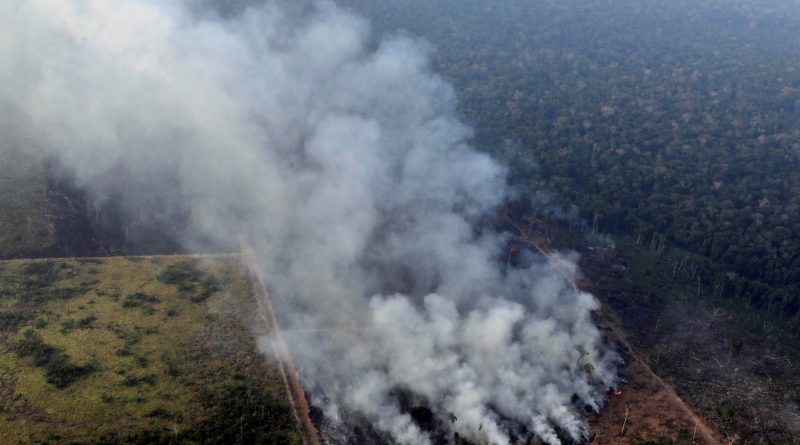Amazon forest fires
“Our house is on fire. Literally.”
Key Actors:
- Jair Bolsonaro – President of Brazil
What’s happening in the jungle?
So far this year, 72,843 fires have been identified in the Amazon rainforest; a 79 percent increase from last year. Scientists estimate that three football pitches of rainforest is lost each minute to the fire. Smoke is covering much of Brazil, reaching further than 2,500 kilometres from the Amazon forest.
Since it is difficult for a wet rainforest to burn naturally, scientists believe almost all of the fires are caused by humans, either intentionally or by accident. Each year, farmers clear areas for their cattle to graze by burning sections of the forest, and these fires can go out of control. Hence, much of the affected area is not old-growth forest but land that is set aside for farming and grazing.
Fiery consequences
This year’s fires have drawn attention to climate change. Often referred to as the Earth’s “lungs,” the Amazon rainforest sinks about 20 percent of the world’s carbon dioxide emissions according to the World Wildlife Fund. However, deforestation, along with other environmental factors, may cause the Amazon to become a source of carbon dioxide instead of a sink. Even before this year’s wildfires, deforestation has caused half a billion metric tons of carbon dioxide to enter the atmosphere. People from around the world are concerned about what losing so much rainforest will mean for climate change.
Indigenous tribes are perhaps the most affected by the fire. Many are being left with nothing but scorched land and dead trees. These tribes depend heavily on their natural resources, and their loss will have grave consequences. (add specific examples if possible. harder to hunt? no wood to work with? no food?)
Politics or global warming?
Since his election in October 2018, Brazil president Jair Bolsonaro has relaxed environmental policies, calling them “an obstacle to economic growth.” As promised, he has cut $23 million from his environmental programs since his election. Ironically, helater claimed that his government lacks the resources to fight the fires. As he decreased funding for environmental programs, illegal activities have increased; his proclamations that Brazil’s protected areas are too big have emboldened farmers to burn land.
President Bolsonaro disagrees with these claims and provides a different explanation for the recent fires. “We took money away from the NGOs, they are now feeling the pinch from the lack of funding,” he says. “So, maybe the NGO types are conducting these criminal acts in order to generate negative attention against me and against the Brazilian government.” However, there is evidence that farmers are burning more land than before due to his loosened policy.
President Bolsonaro’s anti-Indigenous rhetoric is only adding fuel to the fire. There have always been intruders in the Amazon, particularly in the Javari Valley Indigenous Territory. The National Indian Foundation (FUNAI) was established to prevent intruders from damaging the land. However, President Bolsonaro has been dismantling the organization. It suffers from budget cuts so great that only 18 employees are now protecting an area the size of Poland. Shockingly, employees have to pay for some of the equipment out of their own pockets. Relaxed policing means that more illegal loggers, farmers and miners are destroying land, making it more vulnerable to forest fires. Many tribes suspect a connection between the fires and President Bolsonaro’s desire to exterminate the Indigenous people in the Amazon.
Government reaction
On August 23rd, President Bolsonaro said that there will be direct military involvement to enforce environmental laws and contain the fire despite previously saying there was a lack of resources. Governments worldwide have criticized Brazil’s sluggish response to the issue. French president Emmanuel Macron called the situation an “international crisis” and tweeted “Our house is on fire. Literally.” He recommended that the G7 countries – Canada, France, Germany, Italy, Japan, the UK and the U.S. – should discuss this at their meeting thisweekend, to which President Bolsonaro replied, “The suggestion of the French president that Amazonian issues be discussed in the G7 without countries in the region participating is reminiscent of a colonial mindset inappropriate in the 21st century.” Canada will send $15 million and water bombers to help with firefighting efforts.
What can you do?
To help rainforests around the world, you can contribute to organizations like Rainforest Trust and Rainforest Alliance. The Rainforest Trust purchases and protects endangered land whereas the Rainforest Alliance works with businesses to enhance sustainability. Look for The Rainforest Alliance Certified seal when making your next purchase to help the Amazon Rainforest.
Bibliography
Phillips, Tom. “’He Wants to Destroy Us’: Bolsonaro Poses Gravest Threat in Decades, Amazon Tribes Say.” The Guardian, Guardian News and Media, 26 July 2019, www.theguardian.com/world/2019/jul/26/bolsonaro-amazon-tribes-indigenous-brazil-dictatorship.
Symonds, Alexandria. “Amazon Rainforest Fires: What to Know.” The New York Times, The New York Times, 23 Aug. 2019, www.nytimes.com/2019/08/23/world/americas/amazon-fire-brazil-bolsonaro.html.
Scutti, Susan. “Here’s What We Know about the Fires in the Amazon Rainforest.” CNN, Cable News Network, 23 Aug. 2019, www.cnn.com/2019/08/23/americas/amazon-wildfires-411/index.html.

